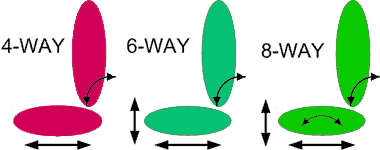Seat Position Controls
- Basic Description
-
Electronic Seat Control is not a new concept in automobiles. In fact, power seats first appeared in automobiles in the 1940's. The major advancements in electronic seat control have been largely centered around functionality, comfort and ease of use. At the inception of power seats, control was typically limited to unidirectional motion towards the front or rear of the vehicle. Modern cars generally employ six-way or eight-way seat control which includes adjustment capability for seat height, angle, forward position and seat back.

Depending on the system, the driver's seat can be adjusted
in four, six, or eight directions.
Additional efforts to increase passenger and driver comfort have led to developments like integrated climate control systems with heating and cooling capability. Another significant development in electronic seat control came with the advent of driver seat memory functionality. The basic idea behind driver seat memory is that the position of all of the motors in the driver seat can be monitored and recorded by the seat controller. The controller can recall specific settings for a limited number of drivers. Each driver that operates the vehicle can set the seat to their preferred position by simply pressing the corresponding button on the control panel. This functionality is very convenient when multiple drivers frequently operate a single vehicle.
Not all electronic seat control advancements have been purely motivated by comfort. As the primary interface between passenger/drivers and the automobile, the seat also plays an important role in terms of safety. One way that electronic seat control has helped to improve collision safety is by monitoring the position of the driver/passengers head during rear impacts. Whiplash is a major safety concern in rear end collisions. Whiplash occurs when a person's head violently whips backwards due to sudden forward acceleration of the vehicle. One way that the seat can help prevent whiplash is to adjust the headrest to the optimum position during collision events to help provide additional support.
Faurecia has introduced seats that communicate with smart phones. A driver can use a smart phone application to measure his or her body size. The smart phone calculates the optimum positions for the various seat surfaces and transmits this information to the seat, which then adjusts itself.
- Sensors
- Position Sensors
- Actuators
- Electric Motors
- Data Communications
- LIN Bus.
- Manufacturers
- Bosch,
Brose, Delphi, Faurecia, Hella, Johnson Controls, Johnson Electric, Kostal, Lear Corporation
- For More Information
- [1] Power Seat, Wikipedia.
- [2] Power Seats, Lawrence Ulrich, Upstart Business Journal.com, July 19, 2007.
- [3] NEC Electronics Seat Control Demo, YouTube, Nov. 20, 2008.
- [4] Faurecia Smart Fit the Seat High Tech App, YouTube, Nov. 18, 2010.
- [5] 2011 Mazda CX-7 Features - Power Driver's Seat Position Memory, YouTube, Jun. 4, 2012.
- [6] Power Seats and Lumbar Controls | Lincoln How-to Video, YouTube, July 23, 2013
|

